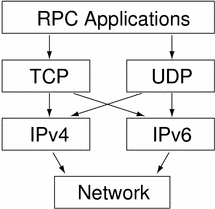IPv6 Considerations for RPC
IPv6 is the successor of IPv4, the most commonly used layer 2 protocol in today's interne technology. IPv6 is also known as IP next generation (IPng). For more information, see System Administration Guide, Volume 3.
Both IPv4 and IPv6 are available to users. Applications choose which "stack" to use when using COTS (Connection-oriented-transport service). They can choose TCP or CLTS (connection-less-transport service).
The following figure illustrates a typical RPC application running over an IPv4 or IPv6 protocol stack.
Figure 4-4 RCP Applications

IPv6 is supported only for TI-RPC applications. TS-RPC does not currently support IPv6. Transport selection in TI-RPC is governed by either the NETPATH environment variable or in /etc/netconfig. The selection of TCP or UDP instead of IPv4 or IPv6 is dependent on the order in which the corresponding entries appear in /etc/netconfig. There are two new entries associated with IPv6 in /etc/netconfig, and by default they are the first two entries of the file. TI-RPC first tries IPv6. Failing that, it falls back to IPv4. Doing so requires no change in the RPC application itself provided that it doesn't have any knowledge of the transport and is written using the top level interface.
|
clnt_create() |
svc_create() |
|
clnt_call() |
clnt_create_timed() |
This interface chooses IPv6 automatically if IPv6 is the first item in /etc/netconfig.
IPv6 enables application only uses RPCBIND protocol V3 and V4 to locate the service bar and number.
|
clnt_tli_create() |
svc_tli_create() |
|
clnt_dg_create() |
svc_dg_create() |
|
clnt_vc_create() |
svc_vc_create() |
It might be necessary to port the code if one of the above interfaces is used.
- © 2010, Oracle Corporation and/or its affiliates
